Essay: Creativity and Innovation in Addressing Global Overpopulation
VerifiedAdded on 2023/06/09
|9
|1670
|251
Essay
AI Summary
This essay explores the application of creativity and innovation in addressing the global issue of overpopulation, utilizing the Osborn-Parnes problem-solving process. The essay begins by acknowledging the increasing complexity of overpopulation and its strain on global resources. It then details the six stages of the Osborn-Parnes process: Mess-Finding, Fact-Finding, Problem-Finding, Idea-Finding, Solution-Finding, and Accepting-Finding, applying each stage to the problem of overpopulation. The Idea-Finding stage generates potential solutions such as providing worldwide access to contraception and sexuality education. The Solution-Finding stage evaluates these ideas using PERT and GANT charts, ultimately highlighting sexuality education as the most promising approach. The essay further employs the SCAMPER technique to refine and enhance the chosen solution. A mind map visually represents the problem and potential solutions. The essay concludes by emphasizing the importance of education in controlling population growth and shaping a sustainable future, advocating for proactive measures to address overpopulation challenges. Desklib provides access to similar essays and study tools for students.

Running Head: CREATIVITY AND INNOVATION
Creativity and innovation
Essay
Student Name
[Pick the date]
Creativity and innovation
Essay
Student Name
[Pick the date]
Paraphrase This Document
Need a fresh take? Get an instant paraphrase of this document with our AI Paraphraser
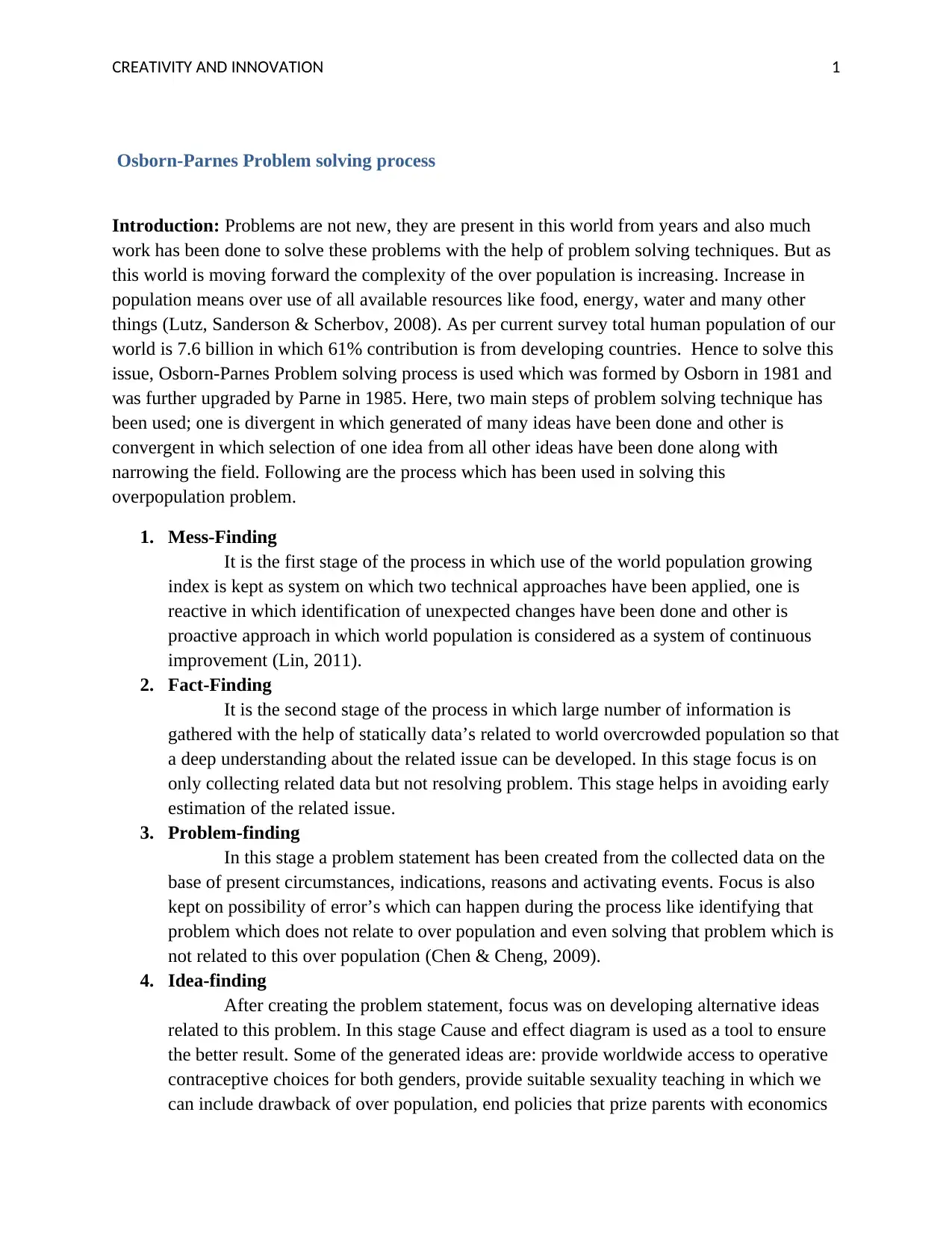
CREATIVITY AND INNOVATION 1
Osborn-Parnes Problem solving process
Introduction: Problems are not new, they are present in this world from years and also much
work has been done to solve these problems with the help of problem solving techniques. But as
this world is moving forward the complexity of the over population is increasing. Increase in
population means over use of all available resources like food, energy, water and many other
things (Lutz, Sanderson & Scherbov, 2008). As per current survey total human population of our
world is 7.6 billion in which 61% contribution is from developing countries. Hence to solve this
issue, Osborn-Parnes Problem solving process is used which was formed by Osborn in 1981 and
was further upgraded by Parne in 1985. Here, two main steps of problem solving technique has
been used; one is divergent in which generated of many ideas have been done and other is
convergent in which selection of one idea from all other ideas have been done along with
narrowing the field. Following are the process which has been used in solving this
overpopulation problem.
1. Mess-Finding
It is the first stage of the process in which use of the world population growing
index is kept as system on which two technical approaches have been applied, one is
reactive in which identification of unexpected changes have been done and other is
proactive approach in which world population is considered as a system of continuous
improvement (Lin, 2011).
2. Fact-Finding
It is the second stage of the process in which large number of information is
gathered with the help of statically data’s related to world overcrowded population so that
a deep understanding about the related issue can be developed. In this stage focus is on
only collecting related data but not resolving problem. This stage helps in avoiding early
estimation of the related issue.
3. Problem-finding
In this stage a problem statement has been created from the collected data on the
base of present circumstances, indications, reasons and activating events. Focus is also
kept on possibility of error’s which can happen during the process like identifying that
problem which does not relate to over population and even solving that problem which is
not related to this over population (Chen & Cheng, 2009).
4. Idea-finding
After creating the problem statement, focus was on developing alternative ideas
related to this problem. In this stage Cause and effect diagram is used as a tool to ensure
the better result. Some of the generated ideas are: provide worldwide access to operative
contraceptive choices for both genders, provide suitable sexuality teaching in which we
can include drawback of over population, end policies that prize parents with economics
Osborn-Parnes Problem solving process
Introduction: Problems are not new, they are present in this world from years and also much
work has been done to solve these problems with the help of problem solving techniques. But as
this world is moving forward the complexity of the over population is increasing. Increase in
population means over use of all available resources like food, energy, water and many other
things (Lutz, Sanderson & Scherbov, 2008). As per current survey total human population of our
world is 7.6 billion in which 61% contribution is from developing countries. Hence to solve this
issue, Osborn-Parnes Problem solving process is used which was formed by Osborn in 1981 and
was further upgraded by Parne in 1985. Here, two main steps of problem solving technique has
been used; one is divergent in which generated of many ideas have been done and other is
convergent in which selection of one idea from all other ideas have been done along with
narrowing the field. Following are the process which has been used in solving this
overpopulation problem.
1. Mess-Finding
It is the first stage of the process in which use of the world population growing
index is kept as system on which two technical approaches have been applied, one is
reactive in which identification of unexpected changes have been done and other is
proactive approach in which world population is considered as a system of continuous
improvement (Lin, 2011).
2. Fact-Finding
It is the second stage of the process in which large number of information is
gathered with the help of statically data’s related to world overcrowded population so that
a deep understanding about the related issue can be developed. In this stage focus is on
only collecting related data but not resolving problem. This stage helps in avoiding early
estimation of the related issue.
3. Problem-finding
In this stage a problem statement has been created from the collected data on the
base of present circumstances, indications, reasons and activating events. Focus is also
kept on possibility of error’s which can happen during the process like identifying that
problem which does not relate to over population and even solving that problem which is
not related to this over population (Chen & Cheng, 2009).
4. Idea-finding
After creating the problem statement, focus was on developing alternative ideas
related to this problem. In this stage Cause and effect diagram is used as a tool to ensure
the better result. Some of the generated ideas are: provide worldwide access to operative
contraceptive choices for both genders, provide suitable sexuality teaching in which we
can include drawback of over population, end policies that prize parents with economics

CREATIVITY AND INNOVATION 2
on the criteria of number of offspring, Increase pricing for ecological cost and adjust
population in those countries where population is very low as compared to area.
5. Solution-finding
In this stage evaluation of all these ideas was done on the basis of fixed criteria.
PERT and GANT charts were used as tools which has given a clear idea about the
strengths and weaknesses of all the generated ideas and their impact on solving the
problem of overpopulation.
6. Accepting-finding
As per results of PERT and GANT charts related to all ideas, providing
appropriate sexuality education stands at the top among all options because as we know
that for any person education or learning forms the base for development of the person. In
education we can utilize data’s, facts and figures in form of topics like checking equality
of sexes, controlling population explosion, developing appropriate reproductive behavior,
proper utilization of nation wealth and maintaining of health (De Mast & Lokkerbol,
2012).
Provide suitable
sexuality teaching
Increase pricing
for ecological
cost
Worldwide access to operative
contraceptive
End policies that prize parents
with economics on the criteria of
number of offspring
Over
population
Adjust population in low
populated countries
on the criteria of number of offspring, Increase pricing for ecological cost and adjust
population in those countries where population is very low as compared to area.
5. Solution-finding
In this stage evaluation of all these ideas was done on the basis of fixed criteria.
PERT and GANT charts were used as tools which has given a clear idea about the
strengths and weaknesses of all the generated ideas and their impact on solving the
problem of overpopulation.
6. Accepting-finding
As per results of PERT and GANT charts related to all ideas, providing
appropriate sexuality education stands at the top among all options because as we know
that for any person education or learning forms the base for development of the person. In
education we can utilize data’s, facts and figures in form of topics like checking equality
of sexes, controlling population explosion, developing appropriate reproductive behavior,
proper utilization of nation wealth and maintaining of health (De Mast & Lokkerbol,
2012).
Provide suitable
sexuality teaching
Increase pricing
for ecological
cost
Worldwide access to operative
contraceptive
End policies that prize parents
with economics on the criteria of
number of offspring
Over
population
Adjust population in low
populated countries
⊘ This is a preview!⊘
Do you want full access?
Subscribe today to unlock all pages.

Trusted by 1+ million students worldwide
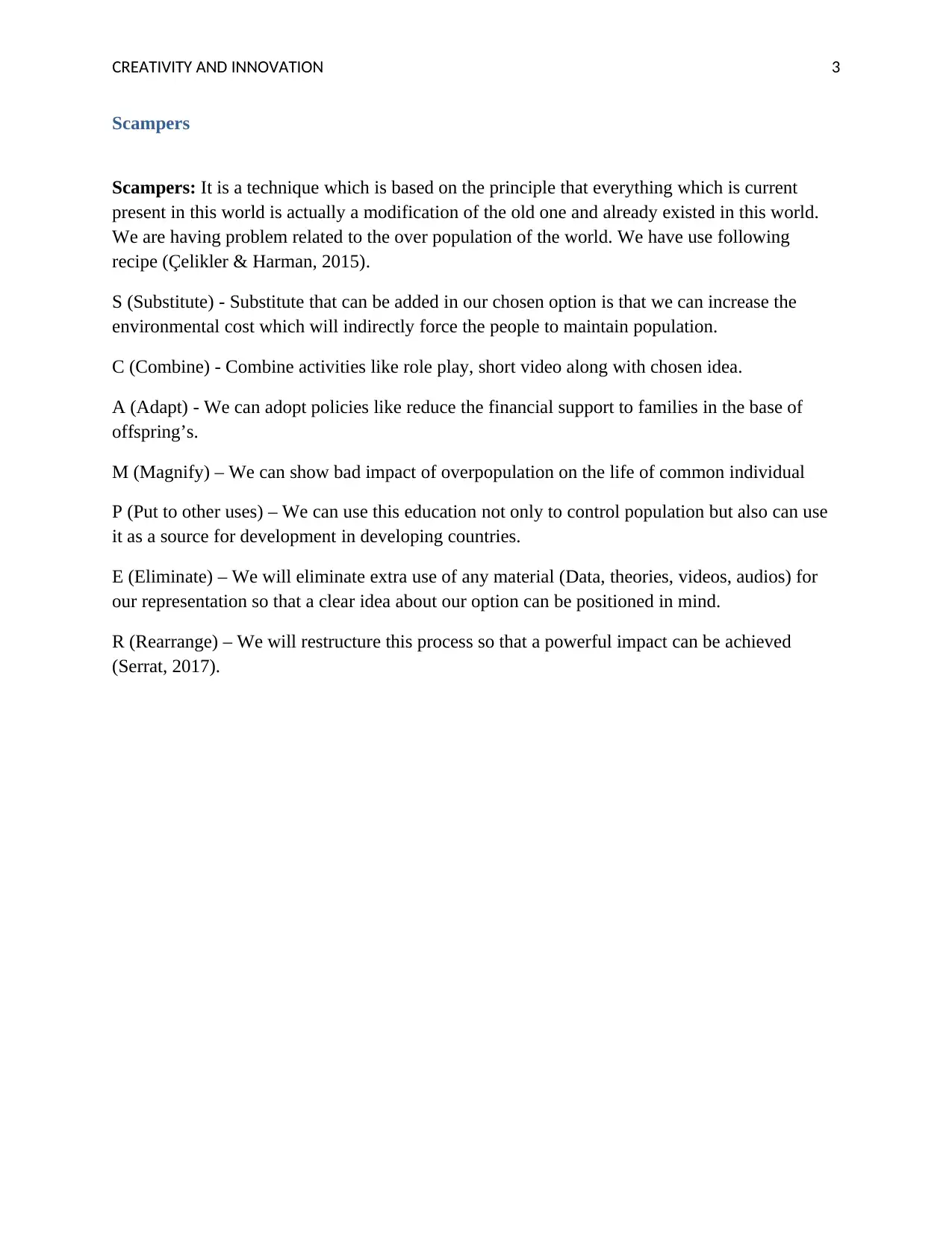
CREATIVITY AND INNOVATION 3
Scampers
Scampers: It is a technique which is based on the principle that everything which is current
present in this world is actually a modification of the old one and already existed in this world.
We are having problem related to the over population of the world. We have use following
recipe (Çelikler & Harman, 2015).
S (Substitute) - Substitute that can be added in our chosen option is that we can increase the
environmental cost which will indirectly force the people to maintain population.
C (Combine) - Combine activities like role play, short video along with chosen idea.
A (Adapt) - We can adopt policies like reduce the financial support to families in the base of
offspring’s.
M (Magnify) – We can show bad impact of overpopulation on the life of common individual
P (Put to other uses) – We can use this education not only to control population but also can use
it as a source for development in developing countries.
E (Eliminate) – We will eliminate extra use of any material (Data, theories, videos, audios) for
our representation so that a clear idea about our option can be positioned in mind.
R (Rearrange) – We will restructure this process so that a powerful impact can be achieved
(Serrat, 2017).
Scampers
Scampers: It is a technique which is based on the principle that everything which is current
present in this world is actually a modification of the old one and already existed in this world.
We are having problem related to the over population of the world. We have use following
recipe (Çelikler & Harman, 2015).
S (Substitute) - Substitute that can be added in our chosen option is that we can increase the
environmental cost which will indirectly force the people to maintain population.
C (Combine) - Combine activities like role play, short video along with chosen idea.
A (Adapt) - We can adopt policies like reduce the financial support to families in the base of
offspring’s.
M (Magnify) – We can show bad impact of overpopulation on the life of common individual
P (Put to other uses) – We can use this education not only to control population but also can use
it as a source for development in developing countries.
E (Eliminate) – We will eliminate extra use of any material (Data, theories, videos, audios) for
our representation so that a clear idea about our option can be positioned in mind.
R (Rearrange) – We will restructure this process so that a powerful impact can be achieved
(Serrat, 2017).
Paraphrase This Document
Need a fresh take? Get an instant paraphrase of this document with our AI Paraphraser
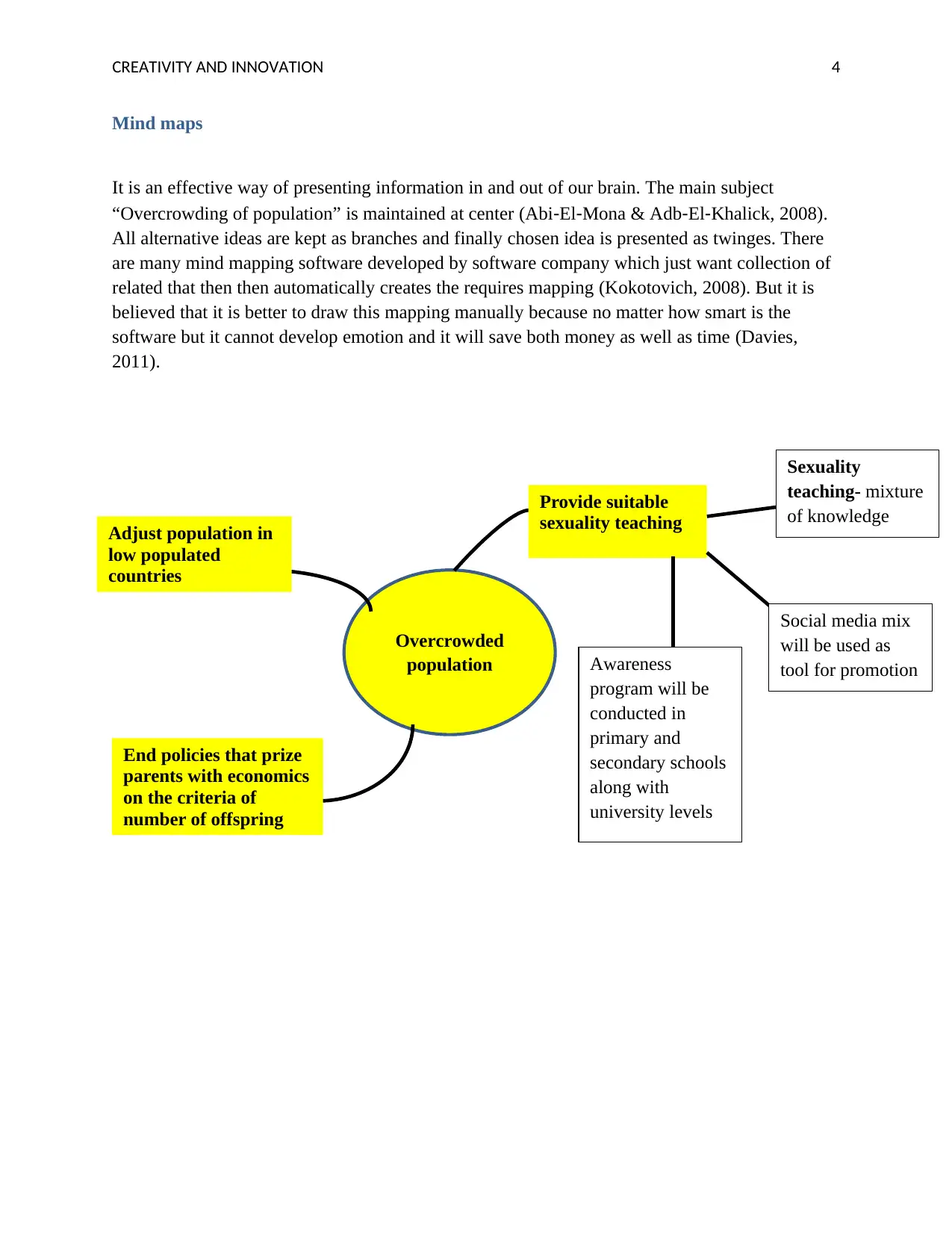
CREATIVITY AND INNOVATION 4
Mind maps
It is an effective way of presenting information in and out of our brain. The main subject
“Overcrowding of population” is maintained at center (Abi‐El‐Mona & Adb‐El‐Khalick, 2008).
All alternative ideas are kept as branches and finally chosen idea is presented as twinges. There
are many mind mapping software developed by software company which just want collection of
related that then then automatically creates the requires mapping (Kokotovich, 2008). But it is
believed that it is better to draw this mapping manually because no matter how smart is the
software but it cannot develop emotion and it will save both money as well as time (Davies,
2011).
Overcrowded
population
Provide suitable
sexuality teaching
Adjust population in
low populated
countries
End policies that prize
parents with economics
on the criteria of
number of offspring
Sexuality
teaching- mixture
of knowledge
Social media mix
will be used as
tool for promotionAwareness
program will be
conducted in
primary and
secondary schools
along with
university levels
Mind maps
It is an effective way of presenting information in and out of our brain. The main subject
“Overcrowding of population” is maintained at center (Abi‐El‐Mona & Adb‐El‐Khalick, 2008).
All alternative ideas are kept as branches and finally chosen idea is presented as twinges. There
are many mind mapping software developed by software company which just want collection of
related that then then automatically creates the requires mapping (Kokotovich, 2008). But it is
believed that it is better to draw this mapping manually because no matter how smart is the
software but it cannot develop emotion and it will save both money as well as time (Davies,
2011).
Overcrowded
population
Provide suitable
sexuality teaching
Adjust population in
low populated
countries
End policies that prize
parents with economics
on the criteria of
number of offspring
Sexuality
teaching- mixture
of knowledge
Social media mix
will be used as
tool for promotionAwareness
program will be
conducted in
primary and
secondary schools
along with
university levels
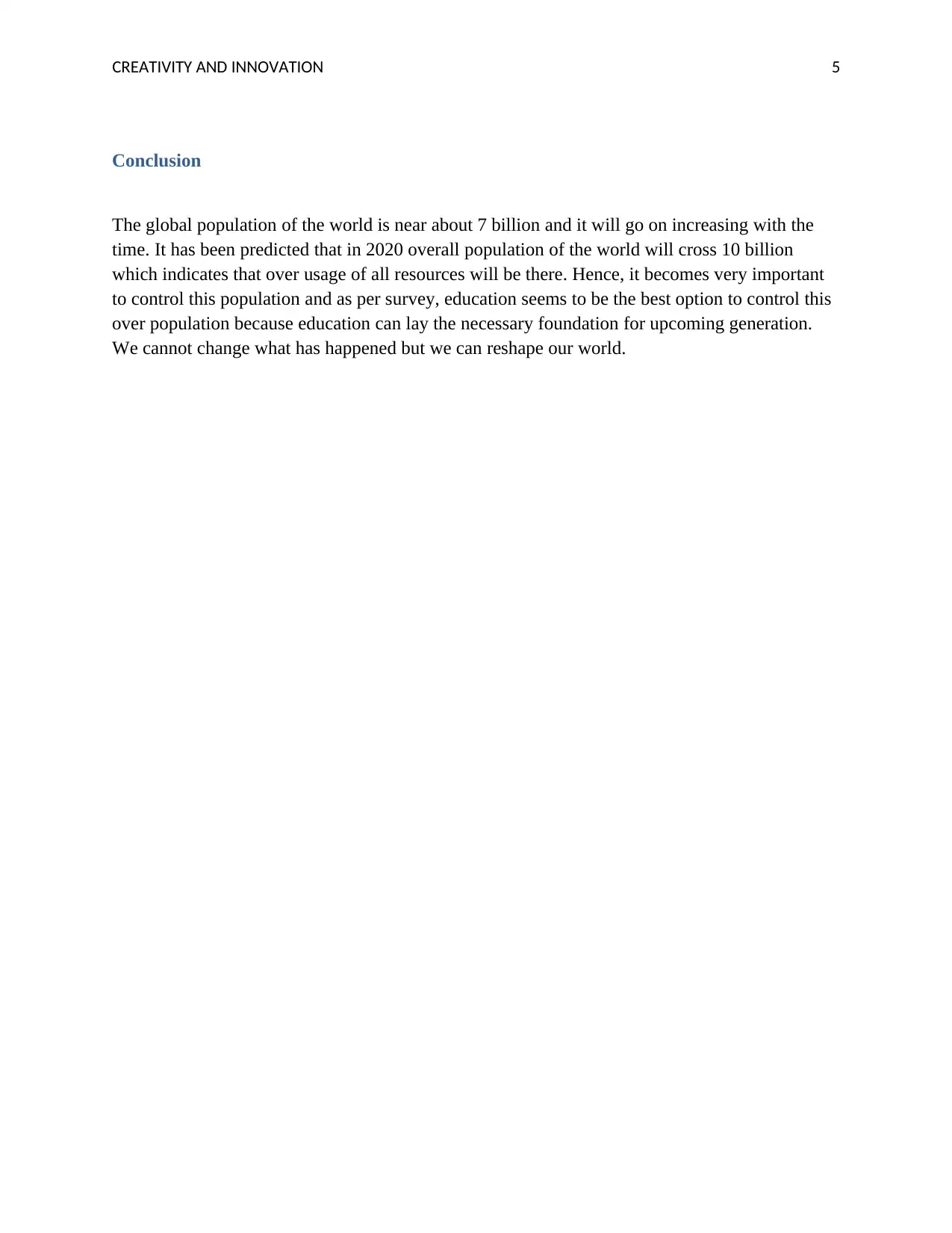
CREATIVITY AND INNOVATION 5
Conclusion
The global population of the world is near about 7 billion and it will go on increasing with the
time. It has been predicted that in 2020 overall population of the world will cross 10 billion
which indicates that over usage of all resources will be there. Hence, it becomes very important
to control this population and as per survey, education seems to be the best option to control this
over population because education can lay the necessary foundation for upcoming generation.
We cannot change what has happened but we can reshape our world.
Conclusion
The global population of the world is near about 7 billion and it will go on increasing with the
time. It has been predicted that in 2020 overall population of the world will cross 10 billion
which indicates that over usage of all resources will be there. Hence, it becomes very important
to control this population and as per survey, education seems to be the best option to control this
over population because education can lay the necessary foundation for upcoming generation.
We cannot change what has happened but we can reshape our world.
⊘ This is a preview!⊘
Do you want full access?
Subscribe today to unlock all pages.

Trusted by 1+ million students worldwide
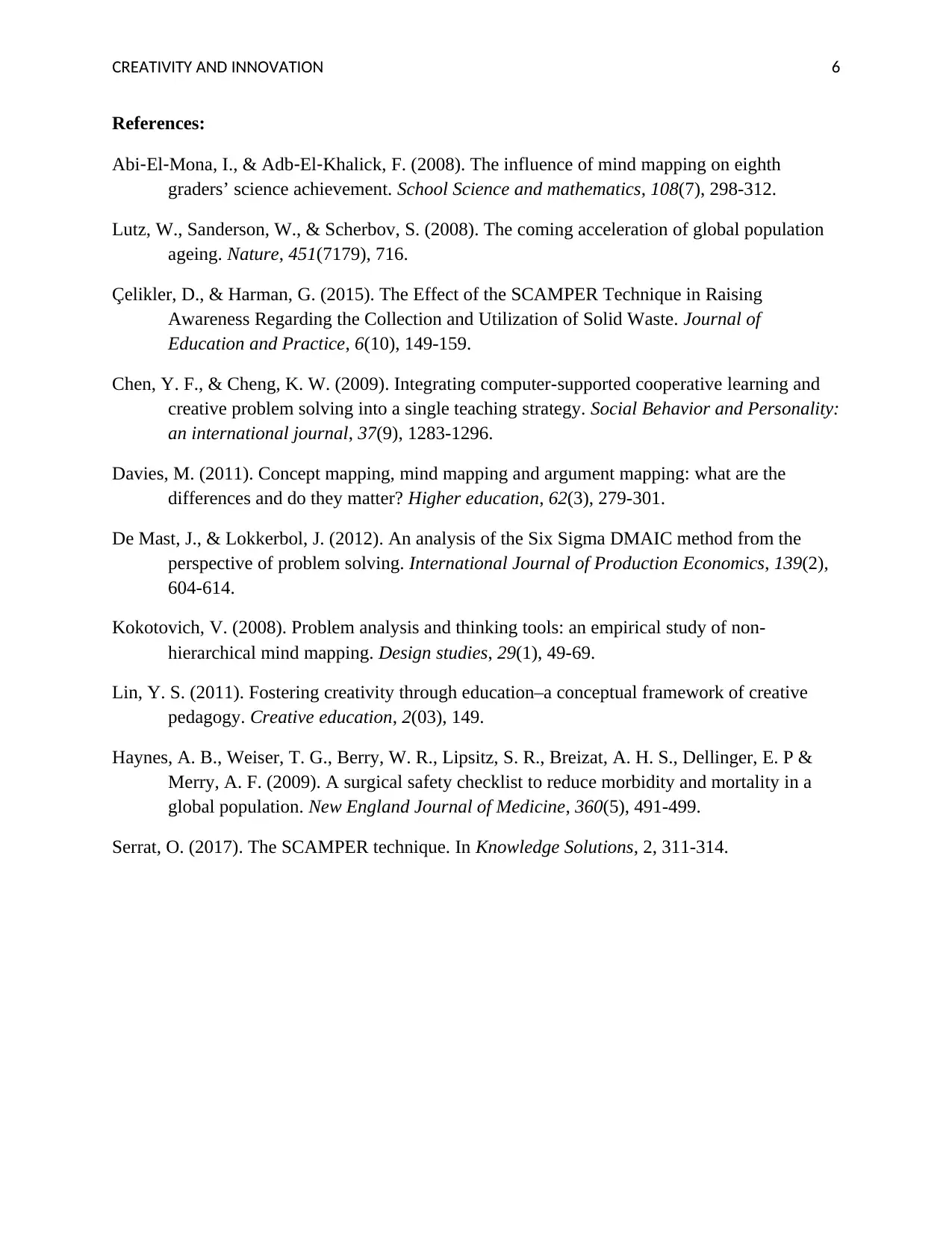
CREATIVITY AND INNOVATION 6
References:
Abi‐El‐Mona, I., & Adb‐El‐Khalick, F. (2008). The influence of mind mapping on eighth
graders’ science achievement. School Science and mathematics, 108(7), 298-312.
Lutz, W., Sanderson, W., & Scherbov, S. (2008). The coming acceleration of global population
ageing. Nature, 451(7179), 716.
Çelikler, D., & Harman, G. (2015). The Effect of the SCAMPER Technique in Raising
Awareness Regarding the Collection and Utilization of Solid Waste. Journal of
Education and Practice, 6(10), 149-159.
Chen, Y. F., & Cheng, K. W. (2009). Integrating computer-supported cooperative learning and
creative problem solving into a single teaching strategy. Social Behavior and Personality:
an international journal, 37(9), 1283-1296.
Davies, M. (2011). Concept mapping, mind mapping and argument mapping: what are the
differences and do they matter? Higher education, 62(3), 279-301.
De Mast, J., & Lokkerbol, J. (2012). An analysis of the Six Sigma DMAIC method from the
perspective of problem solving. International Journal of Production Economics, 139(2),
604-614.
Kokotovich, V. (2008). Problem analysis and thinking tools: an empirical study of non-
hierarchical mind mapping. Design studies, 29(1), 49-69.
Lin, Y. S. (2011). Fostering creativity through education–a conceptual framework of creative
pedagogy. Creative education, 2(03), 149.
Haynes, A. B., Weiser, T. G., Berry, W. R., Lipsitz, S. R., Breizat, A. H. S., Dellinger, E. P &
Merry, A. F. (2009). A surgical safety checklist to reduce morbidity and mortality in a
global population. New England Journal of Medicine, 360(5), 491-499.
Serrat, O. (2017). The SCAMPER technique. In Knowledge Solutions, 2, 311-314.
References:
Abi‐El‐Mona, I., & Adb‐El‐Khalick, F. (2008). The influence of mind mapping on eighth
graders’ science achievement. School Science and mathematics, 108(7), 298-312.
Lutz, W., Sanderson, W., & Scherbov, S. (2008). The coming acceleration of global population
ageing. Nature, 451(7179), 716.
Çelikler, D., & Harman, G. (2015). The Effect of the SCAMPER Technique in Raising
Awareness Regarding the Collection and Utilization of Solid Waste. Journal of
Education and Practice, 6(10), 149-159.
Chen, Y. F., & Cheng, K. W. (2009). Integrating computer-supported cooperative learning and
creative problem solving into a single teaching strategy. Social Behavior and Personality:
an international journal, 37(9), 1283-1296.
Davies, M. (2011). Concept mapping, mind mapping and argument mapping: what are the
differences and do they matter? Higher education, 62(3), 279-301.
De Mast, J., & Lokkerbol, J. (2012). An analysis of the Six Sigma DMAIC method from the
perspective of problem solving. International Journal of Production Economics, 139(2),
604-614.
Kokotovich, V. (2008). Problem analysis and thinking tools: an empirical study of non-
hierarchical mind mapping. Design studies, 29(1), 49-69.
Lin, Y. S. (2011). Fostering creativity through education–a conceptual framework of creative
pedagogy. Creative education, 2(03), 149.
Haynes, A. B., Weiser, T. G., Berry, W. R., Lipsitz, S. R., Breizat, A. H. S., Dellinger, E. P &
Merry, A. F. (2009). A surgical safety checklist to reduce morbidity and mortality in a
global population. New England Journal of Medicine, 360(5), 491-499.
Serrat, O. (2017). The SCAMPER technique. In Knowledge Solutions, 2, 311-314.
Paraphrase This Document
Need a fresh take? Get an instant paraphrase of this document with our AI Paraphraser

CREATIVITY AND INNOVATION 7

CREATIVITY AND INNOVATION 8
⊘ This is a preview!⊘
Do you want full access?
Subscribe today to unlock all pages.

Trusted by 1+ million students worldwide
1 out of 9
Related Documents
Your All-in-One AI-Powered Toolkit for Academic Success.
+13062052269
info@desklib.com
Available 24*7 on WhatsApp / Email
![[object Object]](/_next/static/media/star-bottom.7253800d.svg)
Unlock your academic potential
Copyright © 2020–2025 A2Z Services. All Rights Reserved. Developed and managed by ZUCOL.


